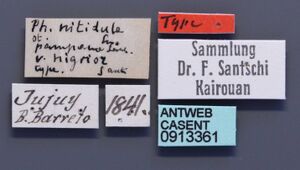Pheidole pampana
| Pheidole pampana | |
|---|---|

| |
| Scientific classification | |
| Kingdom: | Animalia |
| Phylum: | Arthropoda |
| Class: | Insecta |
| Order: | Hymenoptera |
| Family: | Formicidae |
| Subfamily: | Myrmicinae |
| Tribe: | Attini |
| Genus: | Pheidole |
| Species group: | fallax |
| Species: | P. pampana |
| Binomial name | |
| Pheidole pampana Santschi, 1929 | |
Nothing is known about the biology of pampana.
Identification
See the description in the nomenclature section.
Keys including this Species
Distribution
Only known from the type locality.
Latitudinal Distribution Pattern
Latitudinal Range: -24.563333° to -31.657°.
| North Temperate |
North Subtropical |
Tropical | South Subtropical |
South Temperate |
- Source: AntMaps
Distribution based on Regional Taxon Lists
Neotropical Region: Argentina (type locality).
Distribution based on AntMaps
Distribution based on AntWeb specimens
Check data from AntWeb
Countries Occupied
| Number of countries occupied by this species based on AntWiki Regional Taxon Lists. In general, fewer countries occupied indicates a narrower range, while more countries indicates a more widespread species. |

|
Estimated Abundance
| Relative abundance based on number of AntMaps records per species (this species within the purple bar). Fewer records (to the left) indicates a less abundant/encountered species while more records (to the right) indicates more abundant/encountered species. |

|
Biology
Castes
Worker
Minor
Images from AntWeb
   
| |
| Type of unavailable quadrinomial: Pheidole nitidula pampana nigrior. Worker. Specimen code casent0913361. Photographer Z. Lieberman, uploaded by California Academy of Sciences. | Owned by NHMB, Basel, Switzerland. |
Nomenclature
The following information is derived from Barry Bolton's Online Catalogue of the Ants of the World.
- pampana. Pheidole nitidula st. pampana Santschi, 1929d: 283, figs. 6-8 (s.w.m.) ARGENTINA. Raised to species and material of the unavailabel name nigrior referred here: Wilson, 2003: 334.
Unless otherwise noted the text for the remainder of this section is reported from the publication that includes the original description.
Description
From Wilson (2003): A member of the fallax group, similar in various characters to Pheidole bergi, Pheidole cordiceps, Pheidole eidmanni and Pheidole nitidula, distinguished as follows.
Major: head slightly bicolorous (see Color below); humerus in dorsal-oblique view subangulate; rugoreticulum of head covering a swath between each eye and antennal fossa; carinulae absent from center of vertex, and those to each side reach less than half the distance from eye level to level of occiput; anterior strip of pronotal dorsum carinulate.
Minor: pilosity very long, with some hairs longer than Eye Length; pronotum entirely smooth; occiput narrowed, with convex border, but lacking nuchal collar.
MEASUREMENTS (mm) Lectotype major: HW 1.40, HL 1.40, SL 0.86, EL 0.22, PW 0.70. Paralectotype minor: HW 0.72, HL 0.76, SL 0.82, EL 0.20, PW 0.46.
COLOR Major: body concolorous medium reddish brown except for anterior vertex and anterior one-third of head, which is brownish yellow; appendages yellow.
Minor: body plain medium brown, with venter and genae tending to yellowish brown; appendages brownish yellow.
Figure. Upper: lectotype, major. Lower: paralectotype, minor. Scale bars = 1 mm.
=
Type Material
ARGENTINA: Alta Gracia, Córdoba. Naturhistorisches Museum, Basel - as reported in Wilson (2003)
Etymology
Referring to the pampas, the Argentine grasslands where presumably the types were collected. (Wilson 2003)
References
- Wilson, E. O. 2003. Pheidole in the New World: A dominant, hyperdiverse ant genus. Harvard University Press, Cambridge, MA. (page 334, Raised to species: new status, fig. major, minor described)
- Casadei-Ferreira, A., Economo, E.P., Feitosa, R.M. 2020. Additions to the taxonomy of Pheidole (Hymenoptera: Formicidae) from the southern grasslands of Brazil. Revista Brasileira de Entomologia 64(4):e20200068 (doi:10.1590/1806-9665-RBENT-2020-0068).
- Dröse, W., Podgaiski, L.R., Gossner, M.M., Meyer, S.T., Hermann, J.-M., Leidinger, J., Koch, C., Kollmann, J., Weisser, W.W., de S. Mendonça, M., Overbeck, G.E. 2021. Passive restoration of subtropical grasslands leads to incomplete recovery of ant communities in early successional stages. Biological Conservation 264, 109387 (doi:10.1016/j.biocon.2021.109387).
- Jahan, N., Rahman, M., Miah, G., Ahamed, T. 2022. Effects of vegetation types and habitat disturbance on species richness and composition of ant (Hymenoptera, Formicidae) assemblages in Lawachara National Park, Bangladesh. Environment & Ecosystem Science, 6(1): 01-06 (doi:10.26480/ees.01.2022.01.06).
- Santschi, F. 1929d. Nouvelles fourmis de la République Argentine et du Brésil. An. Soc. Cient. Argent. 107: 273-316 (page 283, figs. 6-8 soldier, worker, male described)
References based on Global Ant Biodiversity Informatics
- Drose W., L. R. Podgaiski, C. Fagundes Dias, M. de Souza Mendonca. 2019. Local and regional drivers of ant communities in forest-grassland ecotones in South Brazil: A taxonomic and phylogenetic approach. Plos ONE 14(4): e0215310.
- Kempf, W.W. 1972. Catalago abreviado das formigas da regiao Neotropical (Hym. Formicidae) Studia Entomologica 15(1-4).



